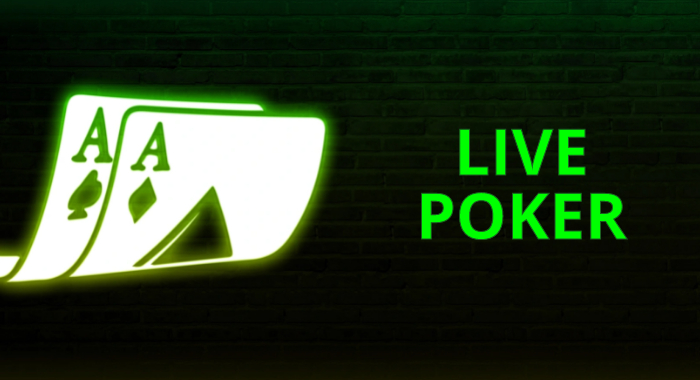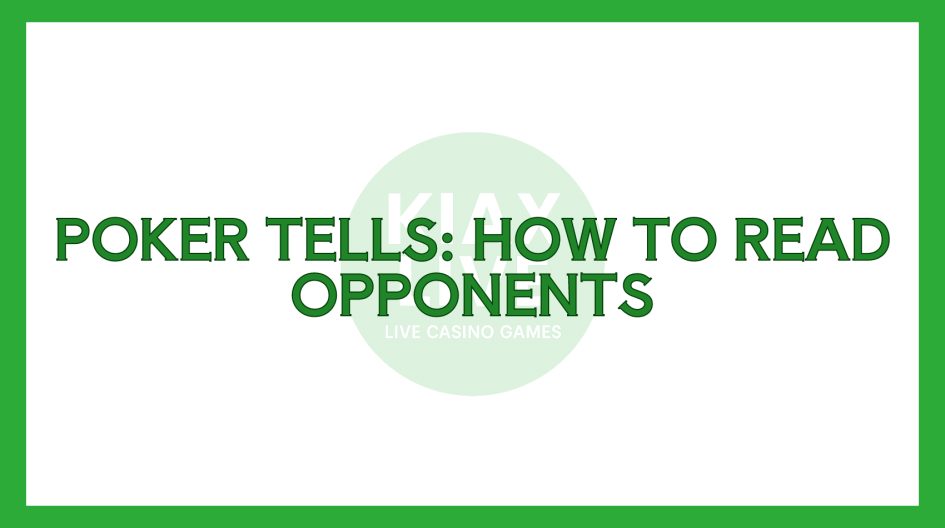Introduction to Poker Tells
Poker is more than just cards and math — it’s a battle of psychology, observation, and decision-making. While the rules of Texas Hold’em or Omaha can be learned in minutes, mastering the ability to read Poker Tells takes time and sharp awareness. In live poker games, both in physical casinos and online live dealer platforms, tells can give you a competitive edge by revealing subtle clues about your opponents’ hands.
In this guide, we’ll explore everything you need to know about Poker Tells: what they are, the different types, how to recognize them, and how to avoid giving them away yourself. By the end, you’ll understand how psychology and behavior can influence your strategy just as much as the cards you’re dealt.
👉 For more live poker content, check out our dedicated Live Poker Category on Kiax Live.
🎡 What Are Poker Tells?
The Definition of a Tell
In poker, a tell is any clue — whether it’s a movement, facial expression, tone of voice, betting style, or even the speed at which someone places chips — that may reveal information about a player’s hand strength or strategy. These cues can be:
- Unintentional (Involuntary): A nervous twitch, a shaky hand, or a quick glance at chips may signal excitement or fear.
- Intentional (Deliberate): Experienced players may fake tells to mislead others, such as pretending to act weak when holding a strong hand.
In live poker environments, especially live dealer games and casino tables, tells are subtle yet powerful. Unlike online RNG poker where everything is digital, live settings allow you to watch people’s actions in real-time, making the study of tells an essential skill.
Why Poker Tells Matter
The ability to spot and correctly interpret poker tells separates casual players from serious competitors. Here’s why:
- Better Decision-Making:
Every poker hand is about making the right choice with incomplete information. Recognizing tells can help you decide whether to fold a losing hand, call a bluff, or raise aggressively with confidence. - Psychological Advantage:
Spotting tells doesn’t just give you information — it gives you control. When you sense weakness, you can pressure opponents. When you sense strength, you can back off without wasting chips. This psychological edge can wear opponents down over time. - Skill Meets Luck:
Poker is often described as a mix of luck and skill. While the cards you’re dealt involve luck, the way you use tells is skill-driven. They inject a human factor into the game that math alone cannot explain, making live poker more dynamic than purely digital versions.
Common Misconceptions About Poker Tells
Many beginners misunderstand how poker tells actually work. Here are a few clarifications:
- A Single Tell Doesn’t Equal Certainty:
One nervous glance doesn’t mean someone is bluffing. Real value comes from observing patterns over many hands. - Not Every Player Has Reliable Tells:
Experienced players may hide their emotions or fake signals. Reading tells works best on casual or intermediate players who are less controlled. - Tells Must Be Combined with Strategy:
Poker tells are not a replacement for pot odds, position, or hand ranges. They are an additional tool to strengthen your decisions, not the sole basis for them.
Key Point to Remember
A poker tell is essentially another layer of information that, when combined with solid fundamentals, helps you make smarter decisions at the table. While it won’t guarantee victory, consistent observation of body language, betting patterns, and behavioral shifts can give you a powerful edge.
💡 Pro Insight: In live dealer poker games online, you may not see every physical tell, but you can still track betting speed, chat behavior, and consistency. Adapting your tell-reading to the environment ensures you always maintain an advantage.
🎡 Common Physical Poker Tells
One of the most fascinating aspects of live poker is watching how players unconsciously reveal information through their physical behavior. These body language cues — whether subtle or exaggerated — are often the first signs that something is going on beneath the surface. While not foolproof, they provide valuable clues when combined with betting patterns and table dynamics.
Nervous Movements
Nervous or restless behavior is often a giveaway of a weak hand or uncertainty. Even players who try to remain calm may subconsciously reveal anxiety. Common examples include:
- Fidgeting with chips or cards: Constantly shuffling, stacking, or clicking chips can show restlessness. In many cases, players do this when they’re unsure about their hand and are looking for comfort in repetitive motion.
- Tapping fingers on the table: This can be a sign of impatience or nervous energy. It may happen when a player is hoping others fold quickly to avoid confrontation.
- Shaking hands when placing bets: This is one of the most well-known physical tells. Shaking hands often indicate nervousness, which can happen when a player is bluffing. Interestingly, in some cases, it can also happen when a player has a very strong hand due to excitement. Context is crucial.
💡 Pro Tip: Always observe whether the nervous movement is consistent across several hands. Some players naturally fidget, while others only show these behaviors under pressure.
Eye Contact
The eyes are one of the strongest indicators in poker psychology. How a player looks (or avoids looking) can reveal hidden confidence or fear:
- Avoidance of Eye Contact: If a player avoids your gaze after placing a bet, it often signals discomfort or weakness. Many bluffers don’t want to risk their eyes betraying them.
- Intense Staring: On the flip side, some players will stare you down in an attempt to project strength. This behavior can be a double-bluff — either covering a weak hand or showcasing genuine confidence.
💡 Key Insight: Eye contact tells are highly situational. Some experienced players use “reverse tells,” deliberately acting weak or strong to mislead observant opponents. Watch for consistency with other behaviors before making a decision.
Breathing and Posture
Breathing patterns and physical stance are powerful indicators because they are often harder for players to control consciously.
- Fast Breathing: Increased heart rate and shallow breaths can signal excitement, often linked to holding a strong hand. Players may also lean forward eagerly when they feel confident.
- Leaning Forward: This “predatory posture” suggests a player is ready to engage and feels they have an advantage.
- Slouching or Sighing: A player who slumps back in their chair, sighs, or looks disengaged may be holding a weak hand. However, beware of players who fake disappointment to lure you into betting more.
💡 Observation Strategy: Watch a player’s baseline behavior. Do they always sit upright? Are they normally relaxed? Any sudden change in posture or breathing is often more meaningful than the action itself.
Why Physical Tells Work Best in Live Games
In live dealer poker and physical casino settings, physical tells are easier to spot than in RNG or purely digital poker games. That’s why professional players invest heavily in studying body language. The key is not to rely on a single tell but to combine physical cues, betting patterns, and timing to form a stronger read on your opponent.
🎡 Verbal Poker Tells
Talking Too Much
Players who suddenly become chatty may be trying to distract attention from a weak hand.
Silence
On the flip side, a player who normally engages but suddenly goes quiet may be concentrating because they have a strong hand.
Tone of Voice
A shaky or higher-pitched voice often indicates nervousness, while calm and steady speech may show confidence.
🎡 Betting Behavior Tells
Speed of Betting
- Instant Bets: Often signal pre-decided bluffs or very strong hands.
- Hesitation: Suggests uncertainty or weakness.
Bet Sizing
- Overly Large Bets: Can mean a bluff trying to push players out.
- Small “Value Bets”: May indicate strong hands trying to lure calls.
Consistency vs Change
Always watch for changes in a player’s usual betting rhythm. Inconsistency is often the biggest giveaway.
🎡 Online Live Poker Tells
Unlike traditional casino poker, live online poker limits your ability to see body language. But you can still observe:
- Betting Timers: Quick actions vs long pauses.
- Chat Box Behavior: Overconfidence or silence can be telling.
- Consistency: Tracking how a player behaves hand after hand.
💡 Even in online environments, poker tells exist — they’re just digital rather than physical.
🎡 How to Use Poker Tells Strategically
Confirm, Don’t Assume
Never base a decision on one tell alone. Look for patterns over time.
Combine with Math
Use tells in conjunction with pot odds, position, and betting ranges. The strongest strategies balance psychology with probability.
Pressure Points
If you notice an opponent is uncomfortable when facing large bets, use that information to push them off marginal hands.
🎡 How to Avoid Giving Away Tells
Control Your Body Language
- Keep movements steady when betting.
- Avoid nervous fidgeting.
- Place chips calmly and consistently.
Manage Your Timing
Don’t make decisions too quickly or too slowly. Keep a balanced rhythm to avoid being predictable.
Stay Aware of Speech
If you normally chat, continue chatting. If you’re quiet, stay quiet. Don’t let sudden changes give you away.
🎡 Famous Poker Tells in Action
Example 1: Bluffing Through Overconfidence
In televised poker, players often exaggerate confidence when bluffing — pushing big bets, leaning forward, and staring down opponents.
Example 2: Weak Hand Nervousness
Amateur players frequently give away their hand strength through trembling hands when betting big for the first time.
These classic examples remind us that human behavior is as much a part of poker as mathematics and strategy.
🎡 Advanced Poker Tells for Experienced Players
Reverse Tells
Skilled opponents may intentionally act weak when they are strong, or vice versa. Recognize this by comparing actions with actual hand outcomes over multiple rounds.
Table Image and Meta-Tells
Your own behavior creates a “table image.” If you’ve been caught bluffing often, your future bets may be read differently. Understanding this dynamic is key at advanced levels.
🎡 Conclusion: Mastering Poker Tells in Live Play

Where Real Dealers Meet Real Wins
Poker Tells add a fascinating layer of psychology to live poker, giving attentive players an advantage. By carefully observing body language, verbal cues, and betting patterns, you can gain valuable insights into your opponents’ hands. But remember — tells are only tools, not guarantees.
Balance your reading skills with solid strategy, bankroll management, and discipline. Over time, this combination creates a well-rounded player capable of thriving in live casino environments.
👉 For more tips, strategies, and guides on live poker, explore our Live Poker Category on Kiax Live.

Leave a Reply